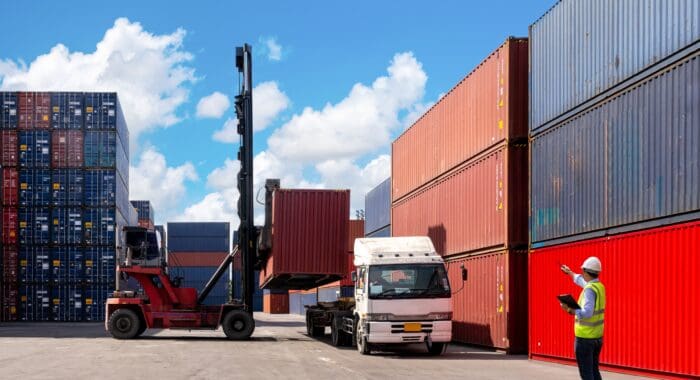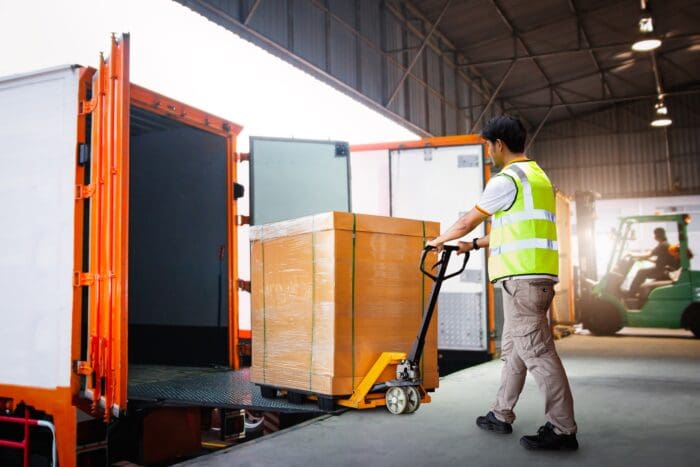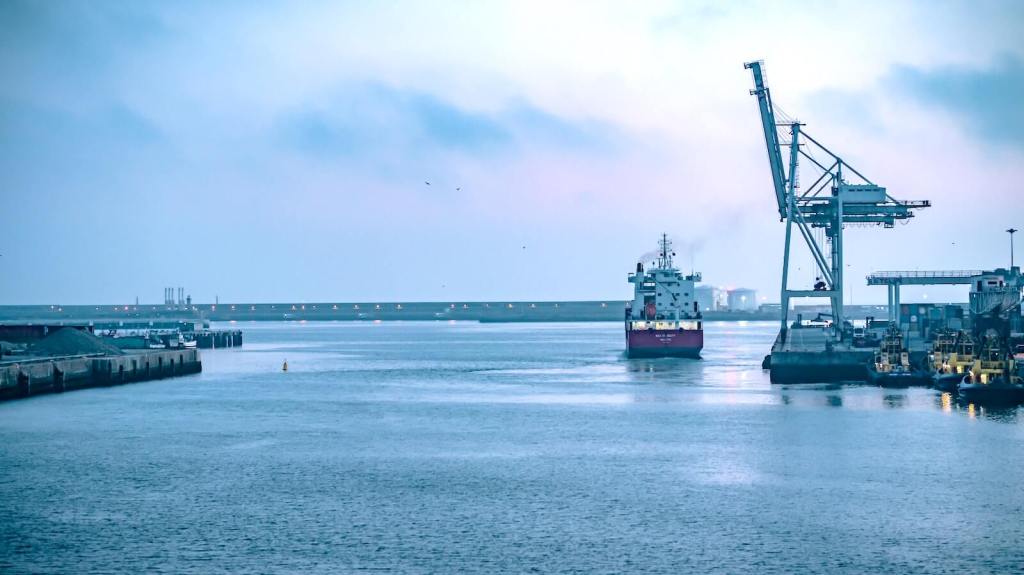Table of Contents
** Minutes
What is international logistics?
Why is international logistics important?
Key international logistics processes explained
What are the challenges of international logistics?
6 strategies to nail international logistics
Why partner with an international logistics company?
In the past, going global was only an option for enterprise brands and the largest retailers. Today, ecommerce businesses of all sizes have more resources than ever before to expand internationally.
Thanks to globalization, getting in front of an international customer base is a huge opportunity. However, the international ecommerce market is competitive – so how does an ecommerce business expand into international markets with a competitive edge?
It all comes down to having a strong international logistics strategy. Shipping international orders is complex, and can be costly and time-consuming. But with the right technology, fulfillment infrastructure, and logistics expertise, you can easily launch into global markets with ease.
In this article, you will learn the ins and outs of international logistics to stay competitive, save onlogistics costs, and meet customer expectations.
What is international logistics?
International logistics are the processes, activities, and functions that work together to movefinished goods through an international supply chain. It consists of cross-border shipping and international inventory distribution to efficiently deliver goods to end users across the globe.
Why is international logistics important?
If your brand currently has or wants to establish a global presence, international logistics is a key aspect of your overall strategy – not one that you can just overlook. This is because:
- It’s critical to customer satisfaction. Having good cross-border logistics in place helps ensure that all customers have the same fast, affordable, high-quality delivery experience, no matter where they live or order from.
- It helps you stay compliant with international laws and regulations. When you carefully coordinate how you move your products, you are able to meet all legal and regulatory requirements for each country you’re shipping to or from.
- It can save you time and money. Seamless, efficient international logistics enable your brand to optimize for cost and spend less time managing international orders.
Even if your brand doesn’t sell to customers around the world, international logistics still directly impact your business’s ability to work with suppliers, obtain raw materials, and receive inbound inventory.
For instance, if there is a global supply chain disruption or bottleneck (as we experienced during the COVID-19 pandemic), it will be much harder for you to get inventory or materials from manufacturers or suppliers. As a result, global logistics issues can lead to delays and problems for your business.
Key international logistics processes explained
Though it’s never been easier fordirect-to-consumer (DTC) brands to break into new markets, establishing an internationalecommerce supply chain adds an extra level of complexity.
From the types of products you can sell and transport overseas to additional costs ofshipping internationally, there is much more involved ininbound and outbound logistics when building a global brand.
Here is an overview of what internationallogistics operations involve.

1. Handling of goods
If you’re looking to expand into new markets, you will need to evaluate your currentphysical distribution of goods. For instance, if you’re storing inventory and shipping orders from a single warehouse location in your home country, you will have to calculate how much it will be to ship an international order overseas (taking landed costs into consideration).
There are several options here: you can still ship international orders from your home country, but you might want to move or expand into a warehousing location that will reduce shipping costs to reach the border before it gets sent overseas.
Or, if you’re seeing a large volume of orders from a different country, you can store some inventory in afulfillment center within that country and have orders picked, packed, and shipped from there.
Global fulfillment reduces many common customs and tariff issues since inventory is already stored within the country and can be shipped domestically.

2. Mode of transportation
Depending on your budget and delivery timelines, you can choose from different modes of transportation to carry your goods to the customer: parcel orfreight shipping, and air, sea, or ground shipping. To make the right decision, you have to consider time, cost, and reliability of each and determine what works for your margins.
Based on where you ship from and where you’re shipping to, several modes of transportation are often involved in delivering an order to an international destination — especially if you’re dealing with cross-border shipping.

3. Transportation process
As the shipper, you send goods to freight forwarders. They liaise with multiple carriers to find the best shipping options (via freight forwarding). Next, the goods are loaded onto trucks, planes, or ships and sent on their way to the end customer. At the destination port, after customs clearance, the goods are unloaded and transported to a specific customer address.
The transportation process for international orders can get tricky. Delivery times vary, depending on where you’re shipping to, and are often slow, since orders are being shipped to another country to different governing bodies and sometimes via several modes of transportation.
To make sure all goes smoothly, double check shipping documentation and the product that you’re shipping meets the country’s trade rules and regulations.
Lastly, it’s important that you make estimatedlast-mile delivery times and any duties they will incur clear with your customers, and then communicate with your customers on any order updates as they wait for their package to arrive.

4. Customs and import duties
Withglobal shipping, you will deal with additional fees, including customs andimport duties (taxes). An import duty is a tax placed on imports by customs authorities in the destination country of the shipment. These duties vary by country and are dictated by the value of the goods being imported.
All global orders need to be cleared through customs of the country they are entering. This involves quite a bit of paperwork, in which you must include the right details (e.g., tariff codes, dollar value, and product descriptions), so orders don’t get held up.
As the shipper, you are responsible for communicating these additional fees to your customers. If a customer is not aware upfront of the additional duties they will have to pay to receive their package, they may never claim it and you are liable for packages that get held up at customs.
That’s why some ecommerce brands chooseDDP shipping (delivery duty paid), in which the seller takes responsibility for all risk and fees of shipping goods until they reach their destination. This way, you won’t risk orders getting sent back when a consumer refuses to pay additional duties and fails to receive the package when it enters their destination country.
What are the challenges of international logistics?
Expanding into international markets can be challenging for several reasons – most of which come down to logistics. Here are the common challenges that hold ecommerce businesses back from going global.
Time-consuming
If not managed properly, internationallogistics operations can be a huge headache for ecommerce companies. Every aspect of the cross-border supply chain, from choosing the right carrier partners to tracking the flow of goods and calculating international shipping costs and transit times, takes a lot of time and energy.
Since there is so much opportunity in going global, many international ecommerce brands reap the benefits of outsourcing international logistics to athird-party logistics partner like ShipBob that has the infrastructure, technology, resources, and expertise to ship international orders efficiently and affordably.
Late shipments
Not only can shipping far from your home country increase transit times, other issues such as customs can cause delays in delivery. No matter where your customers reside, fast and affordable shipping is expected. And if you’re selling ahigh-demand product overseas, chances are there will be competition.
But there are solutions to reduce cross-border shipping delays. One way is tostore inventory within the country you’re shipping to, which reduces transit times significantly, and allows you to worry less about international orders getting held up at customs.
This will not only save you money, but it will also help you meet customer expectations no matter where they live.
“Leveraging ShipBob’s global network to fulfill and ship locally reassures our customers, so that when someone in a key market like Australia or Canada buys from us, they’re not worrying about their order getting stuck in customs or wondering if they’ll ever get their items. They also know it’s not going to take two weeks or more to be delivered, and they don’t have to pay exorbitant international shipping rates.”
Sergio Tache, Founder and CEO of Dossier
International customs & taxes
Each product has a tariff code associated with it for customs. When you ship the goods internationally, you will need to ensure that the right codes are assigned to each SKU, and taxes and other import costs are calculated accurately.
If not managed correctly, your business could face legal action and costly delays if you accidentally assign the wrong code, undervalue shipments, or fill in the wrong details in your customs paperwork. To ensure there are no delays at the border, double check all your documentation.
“Canada is our biggest market outside of the US. We were shipping from our Chicago area warehouse to Canada for a long time. We were missing out on revenue by taking on import fees and taxes. We wanted to outsource fulfillment there to reclaim some of that. We also wanted to help improve customer satisfaction by speeding up their order delivery time and avoiding those frustrating customs hold-ups. Being in ShipBob’s Canadian fulfillment center has been great for us.”
Adam LaGesse, Global Warehousing Director at Spikeball
Poor returns management
Returns are often an unavoidable part of a growing ecommerce business. But handling returns can get tricky, especially with international orders. Return delays will not only frustrate your customers, but reverse-logistics costs will also cut into your profit margins.
If you invest time into creating an efficientreturns management process, it can highly benefit your business.
6 strategies to nail international logistics
To reduce headaches, save money, and make shipping worldwide worth the investment, here are some tips and best practices that will help you optimize your international logistics operations.
1. Check how your products are classified
It’s important to check that all of the products that you wish to sell and ship internationally are allowed to cross and enter foreign borders. Many countries restrict the types of products that can be imported from other countries (even a single ingredient found in your product can cause issues at customs).
This includesprohibited items (e.g., those that are consideredHAZMAT or dangerous goods), packages over a certain weight, and other restrictions at the country-level. Though there is no universal product classification system, different countries use standardized coding systems to distinguish between products.
2. Choose the right packaging
Choosing the right packaging is always important, no matter where you’re shipping to. But with international orders, you’re dealing with packages being in transport for much longer than a domestic delivery, so pay extra attention to packaging.
Before shipping overseas, check the dimensions of your different order sizes.Dimensional weight may likely apply to your shipments and cause the shipping cost to increase, so entering weight and dimensions helps ensure accuracy of the amount charged. It’s a best practice to round up on weights at the pound or ounce level.
You will also want to make sure thatfragile items are packed well with the right amount ofdunnage, and can safely be transported and delivered damage-free, whether orders are being delivered via truck, plane, and/or boat. Rough, long trips through different climates can also damage items easily. Some items will also need additional certain packaging requirements to go overseas.



3. Calculate international shipping costs
Affordable – and especially free – shipping is a huge conversion lever for ecommerce brands.But before letting your customers know that you offer free international shipping, make sure it’s a viable option.
To assess the feasibility of international shipping, you need tocalculate shipping costs based on package measurements, shipment type, weight, international destination, etc.
“Before we had in-country fulfillment in the US, when someone was shopping in the states, they were faced with ridiculous shipping costs. By opening up a warehouse in Arizona, that has completely changed. Now we can offer our US customers shipping costs that are comparable to that in the UK.
We can see the customer’s journey when they’re using our Shopify store. Before we had in-country fulfillment in the United States, we could see how many people would abandon their carts after they saw the shipping costs. Cart abandonment has dramatically decreased, and our conversion rate has improved. Since joining ShipBob, international fulfillment has been incredibly easy, where beforehand it was frustrating.”
Will Kerr, Apparel Lead at Quadrant
When expanding internationally, make sure you do thorough research on import laws, taxes, andimport duties (which can be different for each country) to determine how much it will cost you.
Being proactive in calculating shipping costs can also help you determine which international markets are not feasible for you unless you increase youraverage order value.
4. Update your website and shipping policy
If you’re looking to ship to different countries, it might be worth updating your website to include new shipping destinations and any additional information related to your internationalshipping policy.
An international shipping policy should include mention of shipping costs and methods and estimated delivery times, and specifies additional shipping fees and taxes — and whether or not the customer is responsible for paying them.
Depending on the size of your business, you may want to open unique online stores tailored for each country or region. Another option is to optimize your current website for international buyers with a multi-language translator tool as CAT (Computer-Assisted Translation) tool or createlanding pages optimized and tailored for different countries or regions.
Some other considerations include:
- Tell your customers in that country that you’ll be fulfilling locally (e.g., if you’re expanding in Europe with a facility in the EU, this applies to all countries in the EU). This can help reduce cart abandonment previously attributed to the perceived pains of international shipping like expensive shipping, long delivery times, and having to pay customs and other import duties.
- Update your checkout to show local rates and estimated delivery times, and make sure your store is in local currency.
- Mitigate consumer confusion and increase conversion by making sure product pricing and shipping rates in your UK store are shown in local currency.
5. Estimate shipping times and international tracking
By letting customers know when to expect their package, you can easily manage their expectations. Make sure you haveorder tracking set up that will offer customers real-time updates.
6. Find an international logistics partner
As mentioned earlier, establishing an international logistics strategy is time-consuming. That’s why many international ecommerce brands invest in an international logistics partner to outsource fulfillment and automated shipping.
A professional logistics partner can help you with almost every aspect ofdigital fulfillment and shipping when launching into a new international market. When researching solutions, ask them about their international fulfillment services and how they can help you get set up quickly.
Partnering with a logistics platform that offers both domestic andinternational fulfillment capabilities can solve many of the common challenges of international shipping. Instead of shipping every order across borders, you can bulk ship inventory to an international location so orders can be shipped within the country (or, for example, within the EU or UK). This process makes it much easier to expand globally while reducing the international shipping risks and costs.
Best of all, you can manage inventory and orders that are being fulfilled across the globe from the same dashboard as your domestic shipments, working with the same support team, and having a simplified, consistent experience.
“In the past two years, we have been able to stop questioning our fulfillment limit. Our international sales are no longer limited by what we can ship from our own warehouse in Illinois. Our previous international shipping solutions were far too time-consuming and expensive to process overseas orders from our warehouse. We’ve been able to leverage ShipBob fulfillment centers in 5 countries. That has allowed our sales and marketing teams to reach for greater market internationally, as well as across the US.
ShipBob has helped us grow our international market. We have always asked everyone that we are in business with to look at our relationship as a partnership. A lot of those companies were not interested in us as partners, but ShipBob has always been there for us to help us grow.”
Tom Wall, Vice President of Global Warehousing & Logistics at Beachwaver Co.
Why partner with an international logistics company?
As aglobal fulfillment provider, ShipBob works closely with ecommerce businesses to deliver orders as quickly and accurately as possible by reducing overall costs. With a growing international fulfillment presence, you have the option tosplit inventory across multiple fulfillment centers based on where customers are located across the world.
Here is an overview of the many benefits of partnering with international logistics company like ShipBob:
Reach international customers
The biggest benefit of commissioning a well-known logistics solutions company is that it allows you to reach all of your customers, wherever they are in the world. Thanks to their existing relationships with international freight specialists, you also gain access to more carrier options and shipping destinations than ever before.
For instance, ShipBob offers a growing fulfillment center network, with locations across the United States, the UK, Europe, Canada, and Australia.
“We knew we needed a partner with a global presence, who could handle fulfillment for us wherever we go. Thankfully, ShipBob has fulfillment centers in strategic locations not just across the US, but all over the world. We’re able to store inventory on both coasts of the US and in the UK and EU, which cuts our average shipping costs and shipping times considerably.”
Natalia Lara, CMO of Oxford Healthspan
Save on shipping costs
Though the cost to ship internationally will depend on the destination country among other factors, ShipBob can help you come up with a distribution strategy that will optimize shipping costs.
With ShipBob, there are multiple ways you canreduce shipping costs for international orders: you can choose to store inventory domestically and take advantage of ShipBob’s negotiated carrier rates (even leveraging ShipBob’s inventory placement program to optimize inventory split to reduce shipping times and costs), or you can bulk-ship inventory to one of ShipBob’s international fulfillment locations, so you can ship domestically in other parts of the world.
“Expanding our warehouse network from 2 to 4 warehouses has translated into $1.5 million in freight cost savings for Our Place. It also cut our fulfilment and shipping times in half, from 5 or 6 days to just 2.5 days.”
Ali Shahid, COO of Our Place
Expand to new markets
Are you ready to scale your online business to where your customers are? A global and omnichannel partner like ShipBob can help you launch into markets and expand your customer reach while keepinglogistics costs at a minimum.
Rather than investing time and money into building an international logistics strategy, a logistics parnter already has the distribution network and technology needed to meet customer demand, even internationally, with faster, affordable, and consistent shipping.
Easily fulfill orders
With the right physical and digital logistics partner by your side, you can now fulfill these orders without ever worrying about things likestock issues or shipping costs and delays.
In addition to offeringexpedited shipping for international orders, ShipBob offers international fulfillment center locations to store your inventory and get your orders delivered faster. With multiple strategic locations, we automatically ship orders from the location closest to the destination address.
ShipBob also uses its own proprietary 3PL software that gives merchants real-time updates on inventory stock levels, orders status, and international tracking for orders that have shipped (e.g., via UPS, DHL, and FedEx).

Once an order is shipped, you are sent tracking information, so you can automatically share it with your customers. ShipBob also partners with major carriers to offer discounted domestic and international shipping rates.
“ShipBob has multiple fulfillment centers in the US, one in Canada, one in the EU, and one in the UK.* All locations filter back into one centralized warehouse management system, so everything is under the ShipBob umbrella.”
Wes Brown, Head of Operations atBlack Claw LLC
*View all the latest ShipBob locations here.
How ShipBob helps you ship internationally in 4 steps
Shipping internationally comes with challenges, but that doesn’t mean it’s not manageable — especially if you partner with an expert like ShipBob.
ShipBob offers an international fulfillment network with locations all over the United States as well as in Canada, the UK, Europe, and Australia, and can ship to every country in the world.
Here’s how ecommerce international selling works with ShipBob:
Step 1: Integrate your ecommerce shop and send ShipBob inventory
ShipBob has native integrations with leading ecommerce platforms and marketplaces. Thanks to this functionality, you can easily connect ShipBob’s technology.
Once your products are synced, you can ship your inventory to one or more of our fulfillment center locations. Once orders are placed, they will automatically be sent to ShipBob to be fulfilled and shipped.

Step 2: Set up international shipping options
ShipBob can ship orders internationally, but you have to configure your international shipping options to ensure pricing consistency. Through the ShipBob dashboard, you can easily map domestic ship options to international ones. Learn how to set up your international ship options in ShipBobhere.

Step 3: Set up customs information
The next step is to fill incustoms information (tariff codes, sales prices, and detailed descriptions) about each inventory item in ShipBob’s dashboard. Getting this step right will ensure that your shipment flows smoothly across the border without delays.
Step 4: Expand into fulfillment centers across the globe
As your business grows internationally, you can choose to expand to new markets. If you’re seeing a large volume of orders in a different country, you have the option to expand into one of ShipBob’s international fulfillment center locations.
That way, you save on costs and speed up transit times by shipping a bulk of inventory internationally and have international orders fulfilled and shipped within the country.
Grow global with ShipBob today!
International logistics can be complicated, but you don’t have to navigate the complexities alone. ShipBob makes it easier to launch into new, international markets with confidence.
With our growing global fulfillment network, powered by our best-in-class technology, you’re able to expand your business globally with ease, while reducing shipping costs, speeding up transit times, and creating a great buying experience for your customers everywhere.
To learn more about ShipBob’s international logistics capabilities, read this review or click the button below and we’ll be in touch.
International logistics FAQs
Here are answers to the most common questions related to international logistics:
What are the benefits of international logistics?
One of the best things about launching an ecommerce brand is that it’s easier than ever before to expand into international markets. Tons of online shoppers purchase internationally, which means there is a lot of room to grow your business globally.
How does shipping internationally work?
A lot of research, logistics planning, and communication goes into international shipping. Though picking and packing an international order is similar to a domestic order, shipping internationally gets complex, as a package must travel through different countries to reach its final destination. When shipping goods globally, you need to consider additional shipping costs, regulations by country, and import duties.
What is the best international logistics company?
ShipBob is an international logistics company with fulfillment center locations across the US, as well in the UK, Europe, Australia, and Canada. ShipBob allows you to ship inventory to an international fulfillment center, so you can skip the need to pay for international shipping for every individual order while speeding up transit times.
How do international logistics companies handle customs clearance?
Most international logistics companies are not responsible for handling customs clearance on behalf of brands. Some logistics partners work with customers brokers to manage customs documentation, declaration, customs payment, and release of goods while maintaining regulatory compliance.
How do tariffs and trade agreements affect international logistics?
Tariffs and trade agreements are constantly evolving, which can make it challenging for ecommerce brands with a global presence to comply with regulations, maintain profit margins, and ensure a consistent customer experience for all shoppers regardless of location.
This is why many brands partner with professional international logistics partners, as these experts can help you navigate the complexities of tariffs, trade agreements, and their impact.






